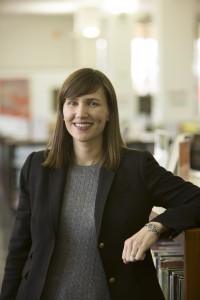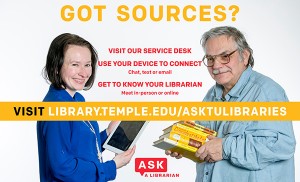By Beckie Dashiell, Editor, Temple University Libraries
I recently had the opportunity to sit down with Annie Johnson, Temple University Libraries’ first Library Publishing and Scholarly Communications Specialist, to speak about her new position. In her dual role, she reports to both the Libraries and Temple University Press. Many of Johnson’s projects will foster collaborations between the Libraries and the Press, which share a reporting relationship and work together to support publishing, scholarly communications, and access to the cultural record.
Beckie Dashiell: Can you begin by telling me about your position and what it entails? And, what new opportunities might your position open up for both the Press and the Libraries?
Annie Johnson: My main role is to act as a bridge between the Libraries and the Press,
and to deepen the connection between the two. Both the Libraries and the Press are thinking about how to better support recent changes in scholarly communication. My job is to develop and coordinate services and programs that address those changes.
BD: Can you share some of the projects you are working on right now?
AJ: I’m involved with the Alternate Textbook Project, which encourages faculty members to use free, open educational resources in their classes instead of costly, commercial textbooks. Since 2011, the Alt-Textbook Project has saved Temple students over $300,000. In addition, I’m helping to launch Temple’s new open access undergraduate research journal, which will be hosted by the Libraries using the Open Journal Systems (OJS) platform. The first issue will be published in 2017.
BD: To briefly circle back to the Alternate Textbook Project you mentioned, I’ve been hearing a lot about open resources and access. Can you speak a bit more to your role in helping the Temple community navigate questions around open access?
AJ: Open access means scholarship that is free to read and use. Many authors are beginning to make their work openly available because it can help them reach a larger audience and increase the impact of their research. However, there are also reasons why authors may not want their work to be open access. Rather than advocating for one mode of publishing or another, my role is to educate students and faculty about publishing scholarship in the digital age.
BD: What’s next as you settle into your work at Temple Libraries and Press?
AJ: At the Press, we’re starting to explore digital publishing, and more specifically, we’re thinking about how we might support the creation of digital companions to print books. The Library has also been working on building an institutional repository, which will serve as a digital archive for faculty and student scholarship. Once launched, it will be a great showcase for all the research going on at Temple. Overall, it’s a really exciting time for both the Libraries and the Press!


